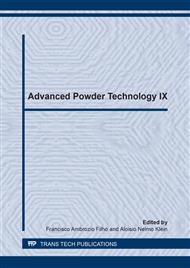p.209
p.215
p.220
p.226
p.232
p.239
p.245
p.250
p.256
Obtaining Ceramic Filter from Rice Husk and Kaolinitic Clay
Abstract:
In this study, different compositions based on rice husk carbon and kaolinitic clay aimed at obtaining ceramic filter were studied. Three compositions of 40, 60 and 80% rice husk of the total mass were prepared. The specimens were uniaxially compressed in rectangular shape at pressure of 28 MPa and were sintered at temperatures of 1100oC, 1150oC and 1200oC for 1 h. The sintered samples were characterized according to standard technique for linear shrinkage, water absorption, apparent porosity and flexural strength. Scanning Electron Microscopy (SEM) was also performed to check the average pore size, and X-Ray Diffraction (XRD) to verify existing crystalline phases, chemical analysis and mercury porosimetry. The X-ray diffraction results showed mostly alpha quartz peaks and mullite after sintering. Mercury porosimetry showed porosity of 44.33% and average pore size of approximately 8.33 μm for sample with 60% rice husk sintered at 1200°C.
Info:
Periodical:
Pages:
232-238
Citation:
Online since:
December 2014
Authors:
Keywords:
Price:
Сopyright:
© 2014 Trans Tech Publications Ltd. All Rights Reserved
Share:
Citation:


